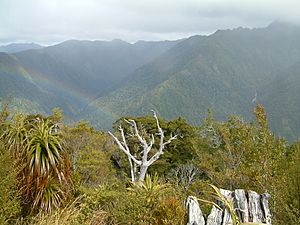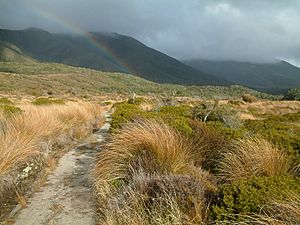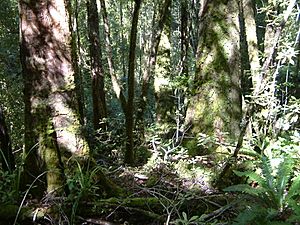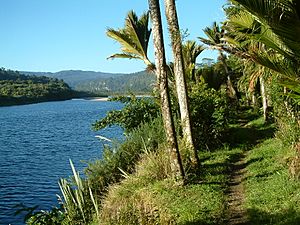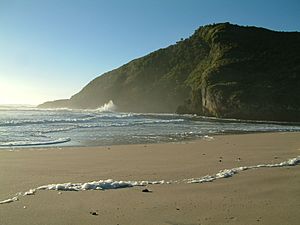Heaphy Track facts for kids
The Heaphy Track is a super popular walking path in the north-west of New Zealand's South Island. It's found inside the amazing Kahurangi National Park. The Department of Conservation calls it one of New Zealand's nine Great Walks, which are special trails.
The track is named after Charles Heaphy. It's about 78.4 kilometers long and usually takes four or five days to walk. The path goes from Kohaihai, which is north of Karamea on the west coast, all the way to the upper valley of the Aorere River, near Golden Bay.
Contents
Track History: A Journey Through Time
Māori tribes lived along the lower Heaphy River as early as the 1500s. We know that Māori explored the area where the Heaphy Track is now. They were looking for special greenstone, called pounamu, in the Gouland Downs area.
First Explorers: Mapping the Way
The first people whose names we know to visit the area were Charles Heaphy and Thomas Brunner. They explored the coastal part of the track in 1846 with their Māori guides, Kehu and Etau.
Later, in 1859, a gold miner named Aldrige was the first European to walk the whole track. James MacKay and John Clark also visited the next year.
Gold Rush and Rediscovery: The Track's Changes
During the West Coast Gold Rush in the 1860s, many people came looking for gold. Prospectors and surveyors helped to properly lay out the track. However, they didn't find much gold, so by 1900, the track was almost forgotten. It became overgrown and only a few hunters used it.
The track was "rediscovered" when the North-west Nelson Forest Park was created in 1965. This park later became Kahurangi National Park in 1996. Since then, the track has been improved a lot. Now, thousands of people enjoy walking the Heaphy Track every year!
Amazing Landscapes Along the Track
The Heaphy Track is famous because its scenery changes so much! Each 20-kilometer part of the track looks very different from the last.
Forests and High Views: Starting the Adventure
If you walk from east to west, your journey starts in a forest filled with beech trees. The path goes up in zigzags to the highest point of the track, which is 915 meters high. From here, you get amazing views of the mountains around you.
Gouland Downs: Wide Open Spaces
After the highest point, the forests change to open grassy areas called tussocks. Soon you enter the Gouland Downs, which is a big, flat area with many rivers. You'll cross these rivers using cool swingbridges, which are very helpful when the rivers are high.
Changing Scenery: From Tussocks to Palms
As you continue, you'll see more patches of trees mixed with the tussock grasslands. Near Gouland Downs Hut, you'll find beech trees covered in thick moss. They look like the very wet forests you might see in southern New Zealand.
After walking through more changing landscapes, you'll reach MacKay Hut. From here, you can see far out to the Tasman Sea. Then, you start a long walk downhill through the forest. This time, you'll see lots of podocarp trees, including huge rimu trees.
Heaphy River Valley: A Peaceful Walk
At the end of the downhill path, you'll reach the Heaphy River valley at Lewis Hut. You'll follow the river for about 8 kilometers on a nice, flat walk. You'll cross the Heaphy River and other smaller rivers on long swingbridges. This part leads you to the incredible nikau palm forest, which is one of the most special parts of the Heaphy Track.
Coastal Beauty: Beaches and Palms
Finally, you'll reach the seashore at Heaphy Hut, right where the Heaphy River meets the ocean. The last part of the track is a coastal walk. You'll walk along sandy beaches where waves crash, and then through forest sections where nikau palms are everywhere.
The Road Debate: Saving the Track
For many years, from the 1950s to the 1980s, some groups wanted to build a road along the Heaphy Track. They thought a road would help more tourists visit the area. However, the government thought building a road would be too expensive and not important enough.
Protecting the Coast: A Special Place
The beautiful coastal part of the track, with its famous nikau palm groves, was especially at risk from any road building. People worried that building a road could cause big landslides, pushing the palm groves into the sea.
Many people living nearby and local councils supported building a road. They believed a "tourist circuit" around the South Island would make the area more popular. But those who wanted to protect the track argued that the damage would be too great. They believed people would prefer to visit the area for days of walking, rather than just driving through quickly.
A Victory for Nature: Changing Attitudes
The big campaign to "save" the Heaphy Track gained a lot of public support. This effort was very important in changing how the government thought about protecting nature. The New Zealand Government then made many changes to stop unnecessary damage to the environment.
After these big campaigns, more and more people started using the track. Now, the Heaphy Track is a key part of New Zealand's amazing walking experiences. Because it became so popular, more money was put into keeping the track in good condition and adding facilities. Today, the track is well-marked and easy to use for people of many different ages. Some companies even offer guided tours and help carry your gear, making it easier for even more people to enjoy this long walk.
Getting to the Track: Road Access
Southern Access
If you're coming from the south, the Karamea-Kohaihai road has a gravel section for the last 4 kilometers (as of January 2018).
Northern Access
From the north, the Collingwood-Browns Hut road is sealed (paved) until Bainham. Then, it's a gravel road for the last 12 kilometers (as of January 2018). This road became an all-weather road in 2014 when bridges were built over three major river crossings near Browns Hut.
Mountain Biking on the Track
Before the area became a National Park, mountain biking was allowed on the Heaphy Track. But when it became a National Park, the National Parks Act 1980 said that vehicles weren't allowed off formed roads. This meant mountain bikers couldn't use the track anymore.
Rules for Riding: Winter Fun
There was a lot of discussion about letting mountain bikers use the track again. In May 2011, the New Zealand Conservation Authority decided to allow mountain biking during the winter months, from May 1 to November 30 each year. This is when fewer people are walking the track.
Since 2016, mountain biking has become a permanent option during these winter months. Groups of up to six riders can enjoy the Heaphy Track from May 1 to November 30 every year.
Images for kids


